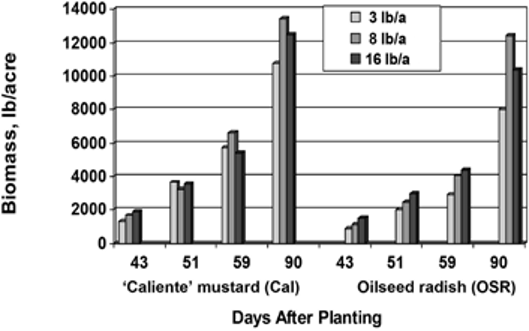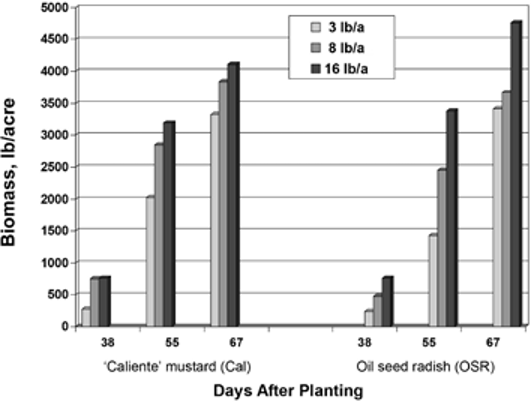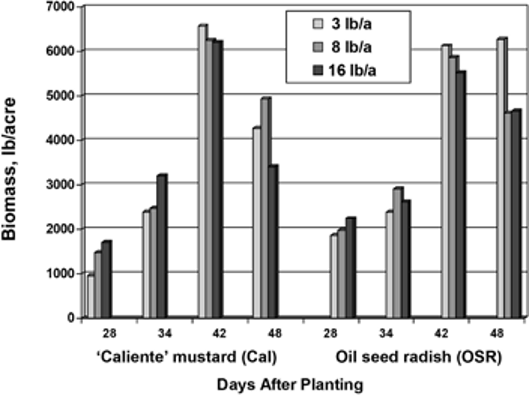Introduction
Cover crops can be a beneficial component of organic and conventional cropping systems. Wind and water erosion protection, nutrient scavenging, pest suppression, and an increase in soil organic matter are all benefits of cover crops. Small grains (rye, wheat, barley, triticale, oats) and legumes (crimson clover, hairy vetch, Austrian winter pea) are widely used winter cover crops (Hoyt et al., 2004). Creamer and Baldwin (1999) offer numerous summer cover crops for consideration in vegetable production systems. A new group of cover crops for winter and summer use include mustards, oilseed radishes, and turnips. These crops belong to the family Brassicaceae, which also includes the vegetable crops radish, turnip, collards, broccoli, cauliflower, and cabbage. When young, these plants resemble turnip greens, are very succulent, and have a low C:N ratio, resulting in rapid decomposition when incorporated into the soil. However, if allowed to mature, bolt, and flower, they produce a large amount of biomass in a short period of time and become woody, resulting in slower decomposition than when killed at an immature stage.
Potential Benefits of Biofumigant Cover Crops
Biofumigant cover crops, including mustards and radish, produce a group of compounds known as glucosinolates. When these Brassica cover crops are chopped with a shredder or flail mower to destroy plant cells, chemical reactions convert these glucosinolates to isothiocyanates (ITCs). ITCs are used commercially in the control of numerous crop pests including nematodes, disease-causing pathogens, and weeds. The chemical fumigants V-Pam and K-Pam control pests with ITCs as described above (Anonymous 2010a, 2010b). Biofumigant cover crops may offer a natural way to fumigate soil with the use of these isothiocyanates.
These potential biofumigants become especially important with the loss of methyl bromide, a fumigant used in the production of high-value vegetable and fruit crops like tomato, pepper, and strawberry. The potential fumigant properties and the physical benefits of cover cropping make Brassica cover crops valuable in cropping systems. However, little is known about the biomass production of oilseed radish and ‘Caliente’ mustard. Therefore, field experiments were conducted in both spring and summer to determine the biomass produced by these two Brassica cover crops at three different seeding rates.
Codorus loam= fine loamy, mixed, active, mesic fluvaquentic Dystrudepts
Elsinboro loam= fine loamy, mixed, semiactive, mesic typic
Hapludults Bradson gravelly loam= clayey, parasesquic, mesic typic Hapludults
Field Experiments
Studies were conducted to evaluate oilseed radish and ‘Caliente’ mustard biomass production. Information on soil types, seeding dates, and fertilization rates are shown in Table 1. All fields were moldboard plowed and disked to prepare a smooth seed bed for the biofumigant cover crops. Pre-plant and top-dress fertilizers were applied based on soil test results and recommendations for collards and turnip greens.
Cover crops were broadcast at 3, 8, or 16 lb/a. The fields were then cultipacked immediately to firm the seed bed. Firming the seed bed proved to be a very important part of establishing these cover crops. Areas of the field missed by the cultipacker had greatly reduced cover crop emergence, even when rain or irrigation occurred soon after seeding. Although a hand seeder was used in our studies to seed cover crops, researchers in South Carolina and Arkansas have planted these cover crops with a grain drill (Norsworthy et al. 2005), offering growers another seeding option.
Plots were arranged in a randomized complete block design with three replications. Cover crop species (oilseed radish, ‘Caliente’ mustard) was the main plot and seeding rate was the sub-plot. Plot size was 15 ft by 15 ft. Biomass of all cover crops was determined several times over the growing season by hand- harvesting plants and determining dry weight per unit area.
Biomass Production
‘Caliente’ mustard biomass was not greatly affected by seeding rates (Table 2, Figure 1, Figure 2, Figure 3). The spring 2007 planting produced an excellent crop of ‘Caliente’, approaching 13,000 lb/a dry matter at 8 and 16 lb/a seeding rate. Conversely, dry matter production decreased for all rates at the final harvest (48 DAP) in the summer 2007 trial (Figure 3). This observation is likely due to competition for water during the flowering and pod-filling growth stages in the dry summer test conditions. Plants, too, were mature and beginning to shed leaves from the stem at the last harvest date (48 DAP). Conversely, plants from the two spring plantings were still producing vegetative growth 67 and 90 DAP. The spring and early summer of 2008 were exceptionally dry in North Carolina, leading to decreased dry matter production in spring 2008 compared to tests in 2007 (Figure 2). Seeding rates increased biomass production throughout the harvest timings. ‘Caliente’ mustard biomass in this study was equal to rye (3,000 to 10,000 lb/a) biomass production (Clark 2007) and exceed biomass production of several legume cover crops (including soybean, cowpea, sesbania, and velvetbean) that have reported biomass production ranging from 1,200 to 4,300 lb/a (Creamer and Baldwin 2000).
Oilseed radish biomass production was generally very similar to ‘Caliente’ mustard production. However, seeding rate seemed to have more of an impact on dry matter accumulation with the oilseed radish than in ‘Caliente’ mustard (Table 2, Figure 1, Figure 2, Figure 3).
All sequential harvests for spring 2007 (Figure 1) and spring 2008 (Figure 2) production produced the greatest biomass at the 16 lb/a seeding rate. High seeding rates may be beneficial early in cover crop growth for some crops to help establish a quick canopy for shade and to compete successfully with weeds. Our data indicates this for the spring plantings. Other researchers report dry matter accumulation for radish ranging from 4,000 to 7,000 lb/a (Clark 2007). Oilseed radish dry matter production ranged from 3,500 to 12,000 lb/a at the termination of our studies, indicating great potential for oilseed radish biomass for a quick cover crop in vegetable growers rotation.
Other Considerations
Prices for oilseed radish and the various brands of ‘Caliente’ mustard cover crop seeds varied from $2.90 per pound to more than $5.00 per pound in early 2010. With this high price per pound, applying seeding rates in the 3 to 8 lb/a range should produce adequate biomass for isothiocyanate production. Many companies that sell vegetable and specialty crop seeds may include some cover crop seeds for sale. Some companies offering Brassica cover crop seeds for sale are Siegers Seed Co., Holland, Michigan; Johnny’s Selected Seeds, Winslow, Maine; Rupp Seeds, Inc., Wauseon, Ohio; and Connell Grain Growers, Connell, Washington. (This list is not inclusive.)
Like any cover crop, Brassica cover crops have limitations. Because these cover crops are closely related to important North Carolina vegetable crops, (cabbage, collards, broccoli, and greens), crop rotation limitations may exist. A grower producing cabbage may not want to use a Brassica species as a cover crop for fear of disease and insect pests in the cover crop affecting the cabbage crop. However, growers producing vegetables not related to the Brassicas, such as tomato, pepper, squash, and melons, or row crops such as corn, cotton, soybeans, wheat, and tobacco, can include Brassicas in a rotation without fear of any pests moving from the cover crop to these marketable crops. Biomass production can be beneficial for the nutrients recycled, carbon added to the soil organic matter pool, and isothiocyanate produced for potential pest reductions.
References
Anonymous. 2010a. Vapam product label. Amvac Chemical Corporation. 4100E Washington Boulevard, Los Angeles, CA 90023.
Anonymous. 2010b. K-pam product label. Amvac Chemical Corporation. 4100E Washington Boulevard, Los Angeles, CA 90023.
Clark, A. (ed.). 2007. Managing Cover Crop Profitably.
3rd ed. Sustainable Agriculture Network, Beltsville, MD.
Creamer, N. G. and K. R. Baldwin. 1999. Summer Cover Crops. HIL-37. Department of Horticultural Science, Raleigh, NC.
Creamer, N. G. and K. R. Baldwin. 2000. An evaluation of summer cover crops for use in vegetable production systems in North Carolina.
HortScience. 35:600-603.
Hoyt, G. D., M. G. Wagger, C. R. Crozier, and N. N. Ranells. 2004. Winter Annual Cover Crops. North Carolina Cooperative Extension Service. AGW-439-58.
Norsworthy, J. K., L. Brandenberger, N. R. Burgos, and M. Riley. 2005. Weed suppression in Vigna unguiculata with a spring-seeded Brassicaceae green manure. Crop Protection. 24:441-447.
Prepared by
Ryan A. Pekarek, former Graduate Student, Department of Horticultural Science, NC State University,
Raleigh, NC 27695
Greg D. Hoyt, Professor, Department of Soil Science, NC State University,
Mountain Horticultural Crops Research and Extension Center, Mills River, NC 28759
David W. Monks, Professor,
Department of Horticultural Science, NC State University, Raleigh, NC 27695
Katherine M. Jennings, Research Assistant Professor,
Department of Horticultural Science, NC State University, Raleigh, NC 27695
Department of Horticultural Science North Carolina State University
Publication date: Jan. 1, 2013
AG-782
Recommendations for the use of agricultural chemicals are included in this publication as a convenience to the reader. The use of brand names and any mention or listing of commercial products or services in this publication does not imply endorsement by NC State University or N.C. A&T State University nor discrimination against similar products or services not mentioned. Individuals who use agricultural chemicals are responsible for ensuring that the intended use complies with current regulations and conforms to the product label. Be sure to obtain current information about usage regulations and examine a current product label before applying any chemical. For assistance, contact your local N.C. Cooperative Extension county center.
N.C. Cooperative Extension prohibits discrimination and harassment regardless of age, color, disability, family and marital status, gender identity, national origin, political beliefs, race, religion, sex (including pregnancy), sexual orientation and veteran status.



